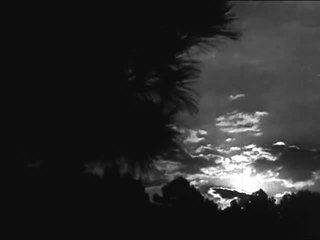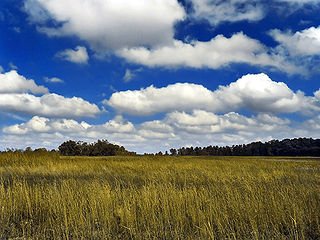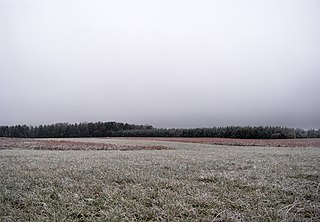
Cirrus is a genus of atmospheric cloud generally characterized by thin, wispy strands, giving the type its name from the Latin word cirrus, meaning "ringlet" or "curling lock of hair". Such a cloud can form at any altitude between 5,000 and 13,700 m above sea level. The strands of cloud sometimes appear as distinctive tufts, commonly called "mares' tails".

In meteorology, a cloud is an aerosol consisting of a visible mass of minute liquid droplets, frozen crystals, or other particles suspended in the atmosphere of a planetary body or similar space. Water or various other chemicals may compose the droplets and crystals. On Earth, clouds are formed as a result of saturation of the air when it is cooled to its dew point, or when it gains sufficient moisture from an adjacent source to raise the dew point to the ambient temperature. They are seen in the Earth's homosphere, which includes the troposphere, stratosphere, and mesosphere. Nephology is the science of clouds, which is undertaken in the cloud physics branch of meteorology. There are two methods of naming clouds in their respective layers of the homosphere, Latin and common.

Cumulus clouds are clouds which have flat bases and are often described as "puffy", "cotton-like" or "fluffy" in appearance. Their name derives from the Latin cumulo-, meaning heap or pile. Cumulus clouds are low-level clouds, generally less than 2,000 m (6,600 ft) in altitude unless they are the more vertical cumulus congestus form. Cumulus clouds may appear by themselves, in lines, or in clusters.

Altocumulus is a middle-altitude cloud genus that belongs mainly to the stratocumuliform physical category characterized by globular masses or rolls in layers or patches, the individual elements being larger and darker than those of cirrocumulus and smaller than those of stratocumulus. However, if the layers become tufted in appearance due to increased airmass instability, then the altocumulus clouds become more purely cumuliform in structure. Like other cumuliform and stratocumuliform clouds, altocumulus signifies convection. A sheet of partially conjoined altocumulus perlucidus is sometimes found preceding a weakening warm front, where the altostratus is starting to fragment, resulting in patches of altocumulus perlucidus between the areas of altostratus. Altocumulus is also commonly found between the warm and cold fronts in a depression, although this is often hidden by lower clouds.

A stratocumulus cloud, occasionally called a cumulostratus, belongs to a genus-type of clouds characterized by large dark, rounded masses, usually in groups, lines, or waves, the individual elements being larger than those in altocumulus, and the whole being at a lower height, usually below 2,000 metres (6,600 ft). Weak convective currents create shallow cloud layers because of drier, stable air above preventing continued vertical development. Historically, in English, this type of cloud has been referred to as a twain cloud for being a combination of two types of clouds.

A nimbostratus cloud is a multi-level, amorphous, nearly uniform and often dark grey cloud that usually produces continuous rain, snow or sleet but no lightning or thunder.

Cirrocumulus is one of the three main genus-types of high-altitude tropospheric clouds, the other two being cirrus and cirrostratus. They usually occur at an altitude of 5 to 12 km. Like lower-altitude cumuliform and stratocumuliform clouds, cirrocumulus signifies convection. Unlike other high-altitude tropospheric clouds like cirrus and cirrostratus, cirrocumulus includes a small amount of liquid water droplets, although these are in a supercooled state. Ice crystals are the predominant component, and typically, the ice crystals cause the supercooled water drops in the cloud to rapidly freeze, transforming the cirrocumulus into cirrostratus. This process can also produce precipitation in the form of a virga consisting of ice or snow. Thus, cirrocumulus clouds are usually short-lived. They usually only form as part of a short-lived transitional phase within an area of cirrus clouds and can also form briefly as a result of the breaking up of part of a cumulonimbus anvil.

Stratus clouds are low-level clouds characterized by horizontal layering with a uniform base, as opposed to convective or cumuliform clouds that are formed by rising thermals. More specifically, the term stratus is used to describe flat, hazy, featureless clouds at low altitudes varying in color from dark gray to nearly white. The word stratus comes from the Latin prefix strato-, meaning "layer". Stratus clouds may produce a light drizzle or a small amount of snow. These clouds are essentially above-ground fog formed either through the lifting of morning fog or through cold air moving at low altitudes over a region. Some call these clouds "high fog" for their fog-like form. While light rain may fall, this cloud does not indicate much meteorological precipitation.

June Gloom is a California term for a weather pattern that results in cloudy, overcast skies with cool temperatures during the late spring and early summer. While it is most common in the month of June, it can occur in surrounding months, giving rise to other colloquialisms, such as "May Gray", "No-Sky July", and "Fogust". Low-altitude stratus clouds form over the cool water of the California Current, and spread overnight into the coastal regions of California.

An actinoform or actiniform describes a collection of marine low clouds that takes a distinct shape. They are named after the Greek word for "ray" due to their radial structure. Actinoform clouds can spread out over 300 km (190 mi) across and thus cannot be easily seen with the naked eye. In addition, actinoform clouds can form "trains" that are up to six times the length of the original cloud field, yet they maintain their own distinct identity.

A marine layer is an air mass that develops over the surface of a large body of water, such as an ocean or large lake, in the presence of a temperature inversion. The inversion itself is usually initiated by the cooling effect of the water on the surface layer of an otherwise warm air mass.

A cold front is the leading edge of a cooler mass of air at ground level that replaces a warmer mass of air and lies within a pronounced surface trough of low pressure. It often forms behind an extratropical cyclone, at the leading edge of its cold air advection pattern—known as the cyclone's dry "conveyor belt" flow. Temperature differences across the boundary can exceed 30 °C (54 °F) from one side to the other. When enough moisture is present, rain can occur along the boundary. If there is significant instability along the boundary, a narrow line of thunderstorms can form along the frontal zone. If instability is weak, a broad shield of rain can move in behind the front, and evaporative cooling of the rain can increase the temperature difference across the front. Cold fronts are stronger in the fall and spring transition seasons and weakest during the summer.

Cirrus floccus is a type of cirrus cloud. The name cirrus floccus is derived from Latin, meaning "a lock of wool". Cirrus floccus occurs as small tufts of cloud, usually with a ragged base. The cloud can have virga falling from it, but the precipitation does not reach the ground. The individual tufts are usually isolated from each other. At formation, the cirrus floccus clouds are bright white and can be mistaken for altocumulus clouds; however, after a few minutes, the brightness begins to fade, indicating they are made up of pure ice, and are therefore at a higher level.

Cirrocumulus floccus is a type of cirrocumulus cloud. The name cirrocumulus floccus is derived from Latin, meaning "a lock of wool". Cirrocumulus floccus appears as small tufts of cloud with rounded heads, but ragged bottoms. The cloud can produce virga, precipitation that evaporates before reaching the ground. Like cirrocumulus castellanus, cirrocumulus floccus is an indicator of atmospheric instability at the level of the cloud. In fact, cirrocumulus floccus can form from cirrocumulus castellanus, being the evolutionary state after the base of the original cloud has dissipated.

Cirrocumulus lenticularis is a type of cirrocumulus cloud. The name cirrocumulus lenticularis is derived from Latin, meaning "like a lentil". Cirrocumulus lenticularis are smooth clouds that have the appearance of a lens or an almond. They usually form at the crests of atmospheric waves, which would otherwise be invisible. This species of cirrocumulus can often be quite elongated and normally has very distinguished boundaries. Cirrocumulus lenticularis forms when stable air is forced upward; this is usually due to orographic features, but can occur away from mountains as well. Irisation can occasionally occur with these clouds.
A cloud étage is a meteorological term used to delimit any one of three main altitude levels in the troposphere where certain cloud types usually form. The term is derived from the French word which means floor or storey, as in the floor of a multi-storey building. With the exception of the low étage, the altitude range of each level varies according to latitude from Earth's equator to the arctic and antarctic regions at the poles.

A castellanus is a cloud that displays at least in its upper part cumuliform protuberances having the shape of turrets that give a crenellated aspect. Some of these turrets are higher than they are wide; they have a common base and seem to be arranged in a line. The castellanus characteristic is particularly obvious when the clouds are observed from the side.

Stratocumulus castellanus or Stratocumulus castellatus is a type of stratocumulus cloud, castellanus is derived from Latin, meaning 'of a castle' This type of cloud appears as cumuliform turrets vertically rising from a common horizontal cloud base, these turrets are taller than they are wide

Stratocumulus lenticularis is an uncommon cloud type that belongs to the stratocumulus cloud type, it's appearance is that of a flat lens or almond. It forms as a result of gravity waves caused by wind passing over obstacles; for example, a mountain or a building. They are more common in locations that are hilly, or places where foehn winds are common They tend to look more well-defined when a foehn wind is causing their formation. They also sometimes show iridescence. It is a type of lenticular cloud.


















